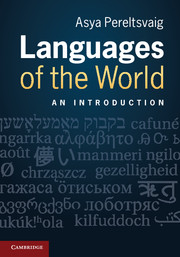Book contents
- Frontmatter
- Contents
- Figures
- Maps
- Tables
- Words, words, words…
- Acknowledgements
- Abbreviations used in the glosses
- 1 Introduction
- 2 Indo-European languages
- 3 Non-Indo-European languages of Europe and India
- 4 Languages of the Caucasus
- 5 Languages of Northern Africa, Middle East and Central Asia
- 6 Languages of sub-Saharan Africa
- 7 Languages of eastern Asia
- 8 Languages of the South Sea Islands
- 9 Aboriginal languages of Australia and Papua New Guinea
- 10 Native languages of the Americas
- 11 Macro families
- 12 Pidgins, creoles and other mixed languages
- Glossary
- References
- Index of languages
- Index of terms
9 - Aboriginal languages of Australia and Papua New Guinea
- Frontmatter
- Contents
- Figures
- Maps
- Tables
- Words, words, words…
- Acknowledgements
- Abbreviations used in the glosses
- 1 Introduction
- 2 Indo-European languages
- 3 Non-Indo-European languages of Europe and India
- 4 Languages of the Caucasus
- 5 Languages of Northern Africa, Middle East and Central Asia
- 6 Languages of sub-Saharan Africa
- 7 Languages of eastern Asia
- 8 Languages of the South Sea Islands
- 9 Aboriginal languages of Australia and Papua New Guinea
- 10 Native languages of the Americas
- 11 Macro families
- 12 Pidgins, creoles and other mixed languages
- Glossary
- References
- Index of languages
- Index of terms
Summary
With the exception of Austronesian languages, discussed in Chapter 8, languages spoken in Australia and Papua New Guinea are relatively poorly studied, nor are the genetic relationships among them clear either. Although some sources refer to these languages as constituting Australian and Papuan language families, these groupings are best understood as geographical terms rather than as valid linguistic classifications since convincing proof for these groupings is yet to be presented.
Attempts have been made – most notably by Joseph Greenberg – to relate Papuan languages to languages outside Papua New Guinea. For instance, Greenberg (1971) proposed that all Papuan languages, as well as Andamanese and the now extinct Tasmanian languages constitute a macro language family which he named “Indo-Pacific”, but other linguists accept the more cautious theory that while some of the languages of Papua New Guinea are related to each other, not all of them are.
- Type
- Chapter
- Information
- Languages of the WorldAn Introduction, pp. 166 - 182Publisher: Cambridge University PressPrint publication year: 2012

